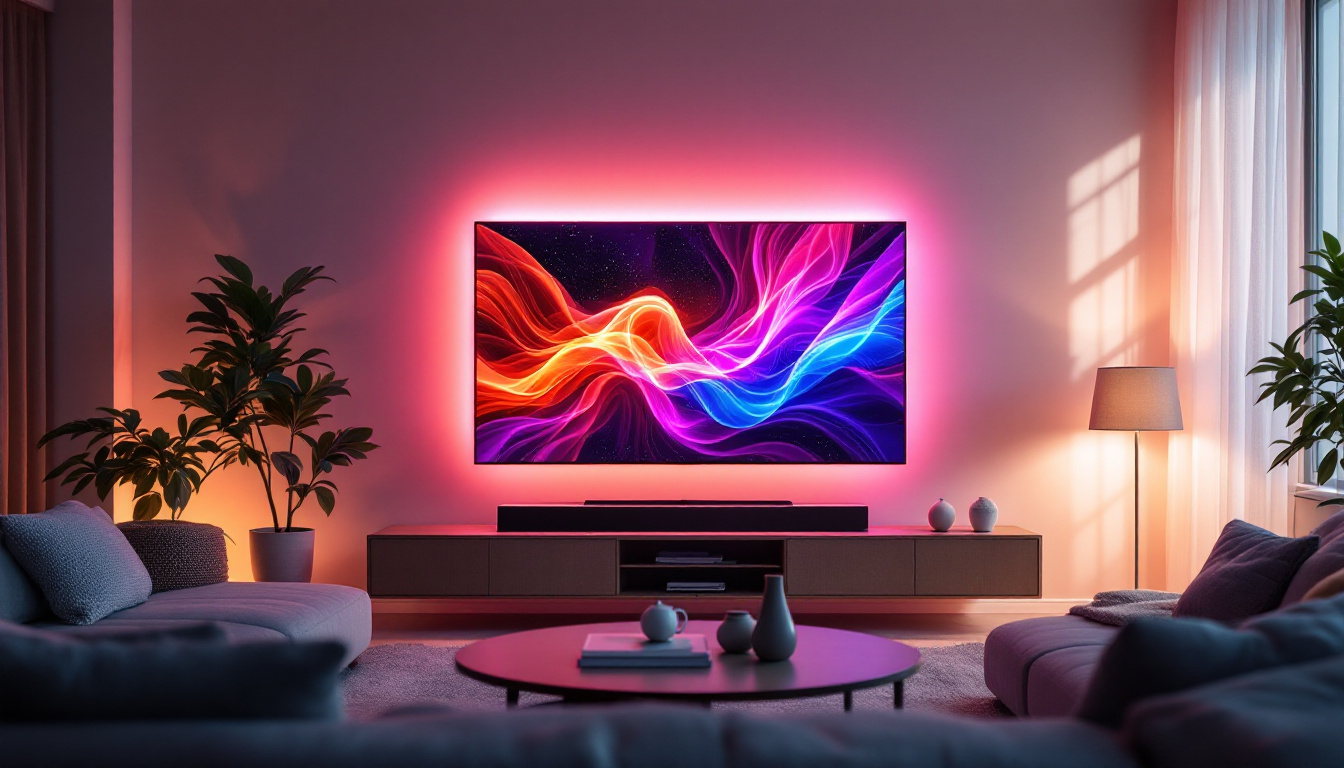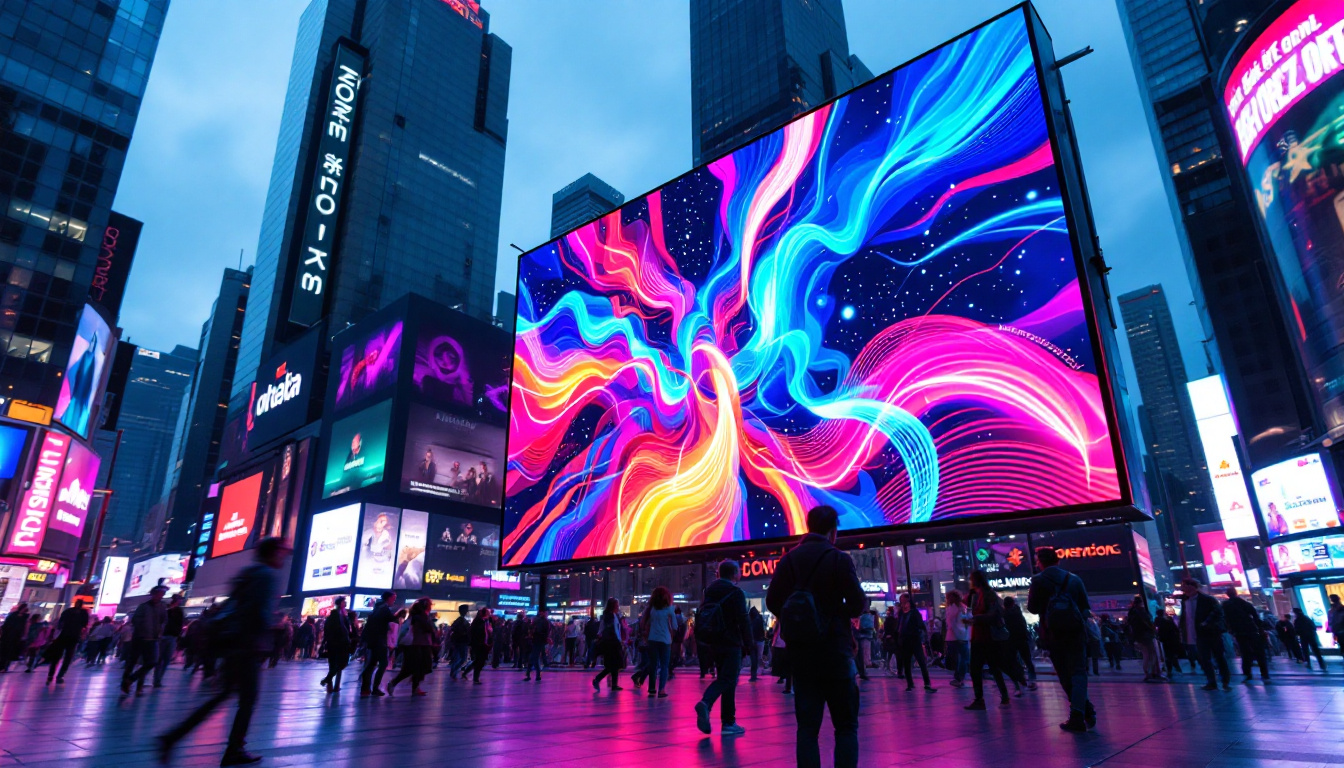In the realm of modern advertising and information dissemination, LED displays have become a cornerstone technology. Among the various types of LED displays, the wall cloud display stands out for its unique design and functionality. This article delves into the intricacies of wall cloud displays, exploring their structure, advantages, applications, and the technology that powers them.
Understanding Wall Cloud Displays
Wall cloud displays are large-scale LED screens that are typically mounted on walls or structures, designed to deliver high-quality visuals in various settings. These displays are characterized by their modular design, allowing for flexibility in size and shape, making them suitable for a wide range of applications.
Structure and Design
The structure of a wall cloud display consists of multiple LED panels that can be arranged in various configurations. Each panel contains a matrix of tiny LED lights that emit bright colors, creating vivid images and videos. The modular design enables easy installation and maintenance, as individual panels can be replaced without disrupting the entire display.
Additionally, wall cloud displays often feature a slim profile, allowing them to blend seamlessly into different environments, whether in retail spaces, corporate offices, or public venues. This aesthetic versatility ensures that they not only serve functional purposes but also enhance the visual appeal of the surroundings. The ability to customize the shape and size of these displays means that they can be tailored to fit unique architectural features, making them an integral part of the design rather than an afterthought.
Furthermore, many wall cloud displays are equipped with advanced mounting systems that allow for tilt and rotation, providing optimal viewing angles for audiences. This adaptability is particularly useful in environments where viewer engagement is paramount, such as museums or exhibition halls, where the display can be adjusted to highlight specific exhibits or presentations.
Technology Behind Wall Cloud Displays
At the heart of wall cloud displays is advanced LED technology. LEDs (Light Emitting Diodes) are semiconductor devices that convert electrical energy into light. This technology offers several advantages over traditional display methods, including lower energy consumption, longer lifespan, and superior brightness.
Moreover, wall cloud displays utilize sophisticated control systems that allow for dynamic content management. Content can be updated in real-time, enabling businesses to display promotions, announcements, or any relevant information instantly. This capability is particularly beneficial in fast-paced environments where timely communication is crucial. The integration of cloud-based software solutions further enhances this functionality, allowing for remote management and scheduling of content from anywhere in the world, which is especially advantageous for businesses with multiple locations.
In addition to real-time updates, many wall cloud displays support interactive features, such as touch capabilities or integration with mobile devices. This interactivity encourages audience participation, making the displays not just a passive viewing experience but an engaging platform for interaction. For instance, in retail settings, customers can browse products or access information by simply touching the screen, creating a more immersive shopping experience that can lead to increased sales and customer satisfaction.
Advantages of Wall Cloud Displays
The adoption of wall cloud displays comes with numerous advantages that make them a preferred choice for various applications. From enhanced visibility to cost-effectiveness, these displays offer a range of benefits that can significantly impact businesses and organizations.
High Visibility and Impact
One of the primary advantages of wall cloud displays is their high visibility. The bright LED lights ensure that content is easily seen, even in well-lit environments. This makes them ideal for outdoor advertising and events, where capturing the attention of passersby is essential.
Furthermore, the dynamic nature of LED displays allows for engaging content that can attract and retain viewers’ attention. Whether it’s a vibrant advertisement or an informative presentation, wall cloud displays can convey messages more effectively than static signage. This capability is particularly beneficial in crowded urban areas where competition for attention is fierce. The use of animations, videos, and real-time data feeds can create a more immersive experience, drawing in audiences and enhancing brand recall.
Cost-Effectiveness
While the initial investment in wall cloud displays may be higher than traditional signage, the long-term cost-effectiveness cannot be overlooked. LED technology is energy-efficient, leading to lower operational costs over time. Additionally, the durability of LED panels means reduced maintenance and replacement costs.
Moreover, the ability to change content quickly and easily eliminates the need for printing new materials, further saving costs and resources. This flexibility allows businesses to adapt their messaging based on current trends or promotions without incurring significant expenses. In addition, many wall cloud displays come equipped with advanced software that enables users to schedule content in advance, ensuring that the right message is displayed at the right time, maximizing engagement and return on investment. This strategic use of technology not only streamlines operations but also enhances the overall effectiveness of marketing campaigns.
Applications of Wall Cloud Displays
Wall cloud displays are versatile and can be utilized across various sectors, each benefiting from the unique features these displays offer. From retail to education, the applications are diverse and impactful.
Retail and Advertising
In the retail sector, wall cloud displays have revolutionized advertising strategies. They provide an engaging platform for showcasing products, promotions, and brand stories. Retailers can create immersive experiences that draw customers in and encourage purchases.
Additionally, these displays can be used to highlight seasonal sales or limited-time offers, ensuring that customers are always informed of the latest deals. The ability to update content in real-time allows retailers to respond swiftly to market changes, enhancing their competitive edge.
Corporate Communication
In corporate settings, wall cloud displays serve as powerful tools for internal communication. They can be used to display important announcements, performance metrics, or even live feeds from company events. This fosters a sense of community and keeps employees informed and engaged.
Furthermore, these displays can enhance presentations during meetings or conferences, providing a visually appealing way to convey information. The dynamic nature of wall cloud displays ensures that presentations are not only informative but also captivating.
Public Information Systems
Wall cloud displays play a crucial role in public information systems, such as transportation hubs, airports, and city centers. They can provide real-time updates on schedules, weather conditions, and emergency alerts, ensuring that the public stays informed.
In addition, these displays can be used for wayfinding, helping individuals navigate complex environments. By providing clear and concise information, wall cloud displays enhance the overall user experience in public spaces.
Challenges and Considerations
While wall cloud displays offer numerous benefits, there are also challenges and considerations that organizations must address when implementing this technology. Understanding these factors can help ensure successful integration and operation.
Initial Investment and Budgeting
The upfront cost of purchasing and installing wall cloud displays can be significant. Organizations must carefully consider their budgets and the return on investment (ROI) before making a decision. It’s essential to evaluate the long-term benefits against the initial expenditure to make an informed choice.
Additionally, ongoing maintenance and potential upgrades should be factored into the overall budget. Organizations should plan for these costs to avoid unexpected financial burdens in the future.
Content Management Challenges
Effective content management is crucial for maximizing the impact of wall cloud displays. Organizations must develop a strategy for creating, updating, and scheduling content to ensure that it remains relevant and engaging.
This may require dedicated personnel or software solutions to manage the content effectively. Without a well-thought-out content strategy, organizations risk displaying outdated or irrelevant information, which can diminish the effectiveness of the display.
The Future of Wall Cloud Displays
The future of wall cloud displays looks promising, with advancements in technology paving the way for even more innovative applications. As the demand for engaging visual communication continues to grow, so too will the capabilities of these displays.
Integration with Smart Technologies
One of the most exciting developments in the future of wall cloud displays is their integration with smart technologies. As the Internet of Things (IoT) expands, wall cloud displays will likely become interconnected with other devices and systems, allowing for more dynamic and responsive content.
This integration could enable displays to adjust their content based on real-time data, such as weather conditions, foot traffic, or social media trends. Such capabilities would enhance their relevance and effectiveness, making them invaluable tools for businesses and organizations.
Enhanced Interactivity
Future wall cloud displays are also expected to feature enhanced interactivity. Touchscreen capabilities, gesture control, and augmented reality (AR) integration could transform how users engage with the content displayed. This interactivity would create immersive experiences that captivate audiences and encourage participation.
As technology continues to evolve, the potential applications for wall cloud displays will expand, offering even more opportunities for businesses to connect with their audiences in meaningful ways.
Conclusion
Wall cloud displays represent a significant advancement in visual communication technology. Their unique structure, high visibility, and dynamic content capabilities make them an essential tool for a variety of applications, from retail to corporate communication and public information systems.
While there are challenges to consider, the advantages and future potential of wall cloud displays far outweigh the drawbacks. As technology continues to evolve, these displays will undoubtedly play an increasingly vital role in how information is shared and consumed in our everyday lives.
Organizations looking to enhance their communication strategies should consider investing in wall cloud displays as a way to engage their audiences effectively and stay ahead in a competitive landscape.
Discover LumenMatrix LED Display Solutions
Ready to elevate your visual communication strategy with cutting-edge technology? Look no further than LumenMatrix, a pioneer in LED display innovation. From captivating Indoor and Outdoor Wall Displays to versatile Vehicle and Sports Displays, our solutions are designed to make your brand shine. Experience the future of digital signage with our Custom, All-in-One, and Transparent LED Displays, each crafted to create unforgettable visual experiences. Don’t miss the opportunity to transform your message delivery and engage your audience like never before. Check out LumenMatrix LED Display Solutions today and witness the power of advanced LED technology.































